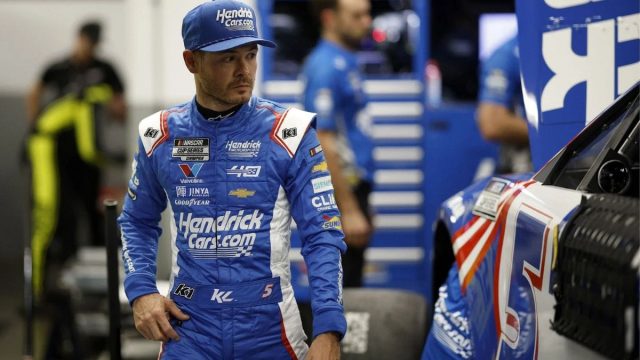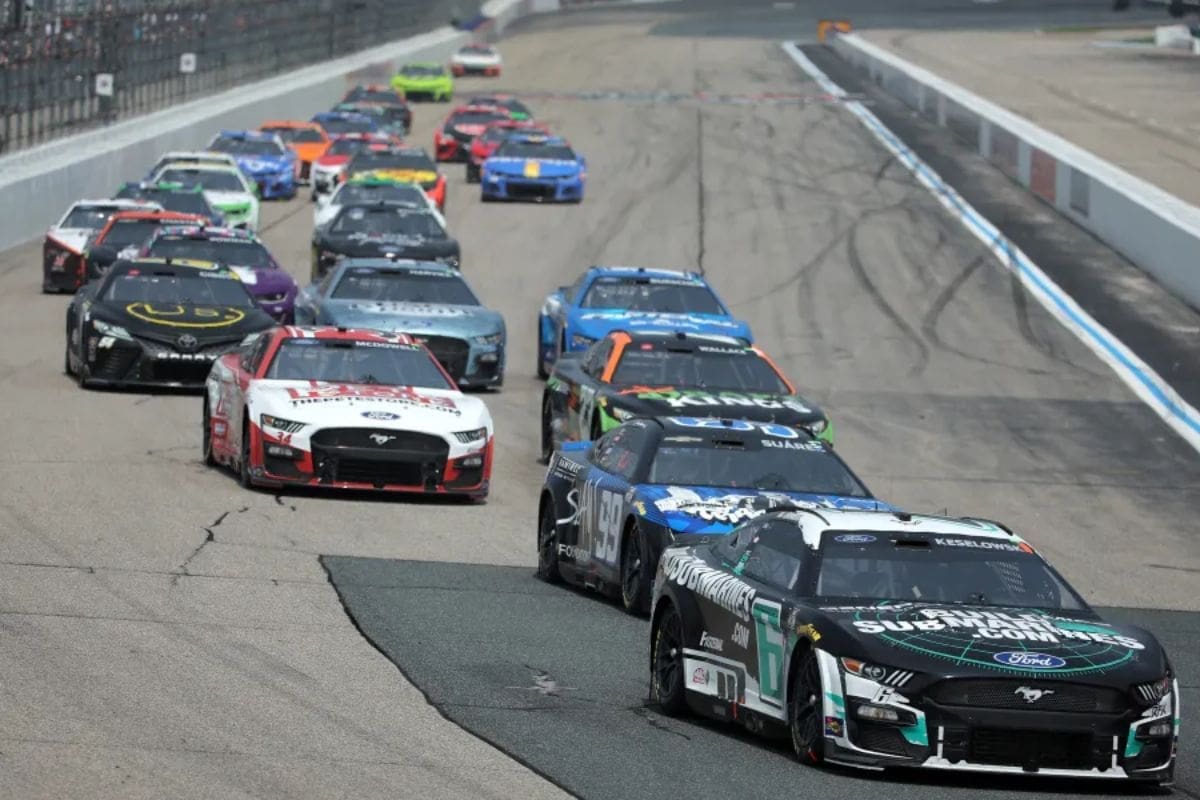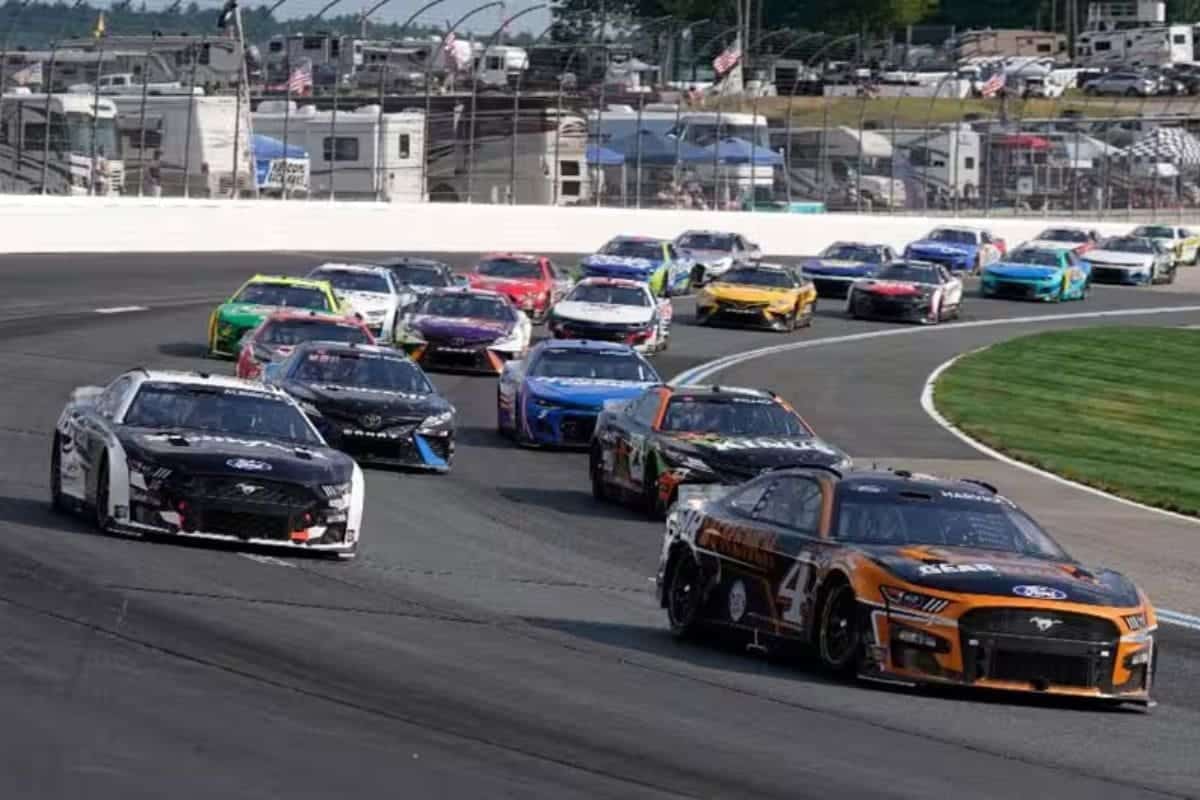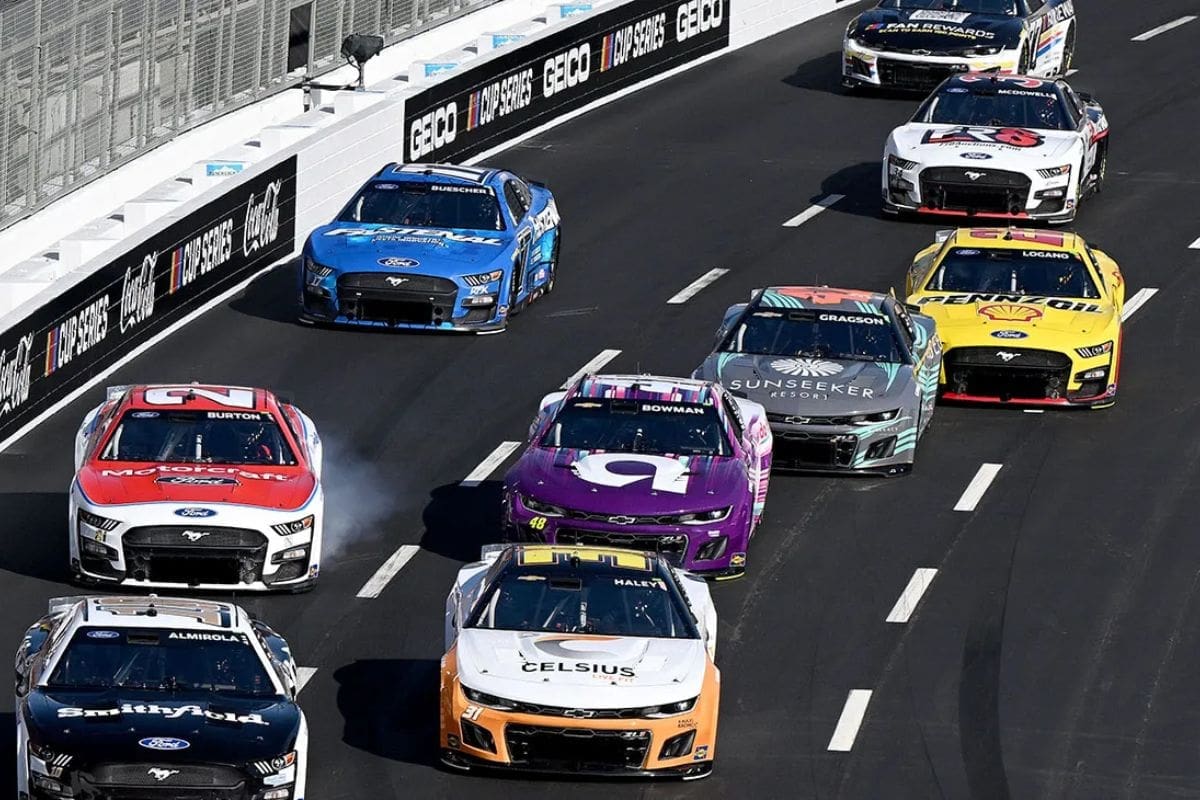Kyle Larson and NASCAR’s Horsepower Debate: The debate about NASCAR’s horsepower regulations has reached a crucial turning point, with prominent drivers like Ryan Blaney and Kyle Larson voicing their concerns. Blaney’s recent victory, coupled with his outspoken criticism of restricted horsepower, has brought the issue into sharp focus, emphasizing the tension between competitive balance and the quest for thrilling races. NASCAR’s cautious stance, driven by financial considerations and technical unpredictability, complicates the dialogue. As the sport grapples with these opposing forces, the question remains: can NASCAR find a middle ground that satisfies both the drivers and fans while safeguarding its future?
Key Highlights
- Blaney and Larson criticize NASCAR’s restricted horsepower, demanding for an increase to enhance racing dynamics and fan excitement.
- NASCAR maintains lower horsepower to manage financial sustainability and competitive balance amid technical and strategic challenges.
- Increasing horsepower to 1,000 would require extensive and costly engine modifications, affecting existing teams and new manufacturers.
- Drivers argue higher horsepower is crucial to maintaining NASCAR’s identity and improving passing opportunities on short tracks.
- NASCAR’s cautious approach to horsepower adjustments reflects concerns about financial implications and the industry’s future amid alternative fuels exploration.
Introduction and Charter Negotiations
The ongoing charter negotiations within NASCAR have become a focal point of dispute and worry, reflecting deeper issues within the organization that affect drivers, teams, and fans. The current standstill in negotiations highlights a broader crisis in governance and strategic alignment within NASCAR, raising concerns about the sport’s capacity to adapt to evolving market dynamics and stakeholder expectations.
Charter agreements, which fundamentally determine team financing, sponsorship deals, and competitive parity, have not been concluded, sowing uncertainty across the board. This lack of resolution is particularly troubling as it hinders teams’ ability to plan long-term investments, complicates driver contracts, and disrupts the competitive landscape.
At the core of these negotiations is the balance between maintaining traditional values and embracing innovation. Teams and drivers are pushing for terms that offer financial stability and equitable revenue sharing, crucial for sustaining competitive operations in a sport that is as capital-intensive as NASCAR. However, the governing body’s hesitation or delay in finalizing these charters might reflect deeper strategic indecisiveness or conflicting interests within the organization. This disarray is noticeable among fans as well, who crave stability and transparency in the sport they passionately follow.
The protracted negotiations also highlight a critical need for improved communication and collaboration between NASCAR’s leadership and its key stakeholders. The current scenario, marked by prolonged uncertainty, diminishes the confidence of sponsors and investors, potentially threatening the sport’s financial health. As these negotiations drag on, the effects are felt throughout the ecosystem, emphasizing the urgent need for a resolution that aligns with the interests of all parties involved.
Ryan Blaney’s Victory and Emotions
Amid the ongoing turbulence in NASCAR’s charter negotiations, Ryan Blaney’s recent victory at Iowa Speedway provided a much-needed moment of elation and relief for both the driver and his team. This success ended a frustrating 17-race winless streak, highlighting the resilience and tenacity of the Team Penske driver.
Blaney, last year’s Cup Series champion, had been under significant stress to reclaim his winning form, and Sunday’s result was a testament to his skill and perseverance.
Blaney’s victory was not just a personal milestone but also a critical morale enhancer for Team Penske. The #12 driver exhibited impeccable racing skills, driving on the Iowa Speedway with precision and strategic poise. His performance was a reminder of his championship pedigree, a crucial factor as the team seeks to build momentum for the remainder of the season.
I figured with his family history of building engines, Chase Elliott would have a unique perspective on the horsepower debate. What he said about the impact if NASCAR changed its mind (to be clear — not expecting a change) and increased horsepower as well as impact on tire wear. pic.twitter.com/yN0zvnAySb
— Bob Pockrass (@bobpockrass) March 17, 2024
However, Blaney’s post-race demeanor revealed complex emotions. While visibly ecstatic about the win, his recent comments have painted a contrasting picture of unease. In interviews, Blaney has openly discussed the challenges and demands that come with competing at the highest level of motorsports.
Issues with Next-Gen Car and Horsepower
Concerns surrounding the Next-Gen car’s performance, particularly its horsepower limitations, have sparked a heated debate among NASCAR drivers and stakeholders. Since its introduction in 2022, the Gen-7 car has faced scrutiny, especially regarding its performance on short tracks. Drivers like Ryan Blaney have voiced their dissatisfaction, pointing out that racing dynamics have suffered due to the restricted horsepower.
Blaney, celebrated for his recent victory at Iowa Speedway, has not shied away from expressing his concerns. Despite his personal success, he acknowledges that the overall racing experience at many short tracks this season has fallen short of expectations. This sentiment is echoed by fellow drivers, who argue that the horsepower limitations hinder the competitive spirit and thrill traditionally associated with NASCAR racing.
Kyle Larson, a prominent figure in the sport, has been particularly vocal. During an appearance on The Dale Jr Download podcast, Larson criticized NASCAR’s justification for maintaining lower horsepower. He questioned the rationale that reduced horsepower would attract new manufacturers, pointing out that the same three manufacturers have dominated the sport for over a decade.
“I feel like they’ve [NASCAR] always use the excuse of or at least I’ve heard the excuse of well you know we’re trying to keep horsepower to where you know other manufacturers might want to come in. Well, as long as I’ve been in the sport which is longer than 10 years it’s been the same three manufacturers.” – (larson)
Larson criticized NASCAR but pointed out that engine builders are ready to provide more horsepower. Larson’s comments highlight a broader frustration within the driver community, emphasizing a desire for changes that could enrich the racing experience.
“So, maybe somebody else is coming and maybe they’re the ones pushing for lower horsepower. But I’ve yet to see anybody new come in and all these you know engine builders and teams are saying it’s not going to cost any different to do it.” – (larson)
I figured with his family history of building engines, Chase Elliott would have a unique perspective on the horsepower debate. What he said about the impact if NASCAR changed its mind (to be clear — not expecting a change) and increased horsepower as well as impact on tire wear. pic.twitter.com/yN0zvnAySb
— Bob Pockrass (@bobpockrass) March 17, 2024
NASCAR’s Stance on Horsepower
NASCAR’s steadfast stance on keeping lower horsepower, despite growing demands from drivers, highlights the intricacies and challenges associated with changing the current performance specifications. Central to NASCAR’s position is the concern articulated by John Probst, NASCAR’s Chief Racing Development Officer. Probst has consistently pointed out that increasing horsepower is not a straightforward endeavor. He emphasized, “If you add the horsepower, you add the cost, then you see if it is better.” This statement highlights the financial implications and the potential uncertainty in achieving improved racing quality.
Probst further elaborated on the lack of guaranteed benefits, indicating that increasing horsepower might not necessarily lead to better racing. He noted, “There’s no guarantee you get there, and it would be any better. And I think there’s some evidence that shows as we add horsepower, they run further apart. There’s some that shows it’s better … and there’s some other shows no, might not be. So that’s a heck of a gamble to take with the entire industry.” This ambiguity creates a significant gamble for the entire industry, which NASCAR appears reluctant to take. The inherent risks of altering engine specifications, coupled with historical data showing mixed results, have fortified NASCAR’s resolve to stick with the current horsepower limits.
"I don't know if it's [horsepower] a winnable war at this point – but we are going to keep fighting!" 🐎 pic.twitter.com/eMX3W1EWDJ
— Dirty Mo Media (@DirtyMoMedia) June 19, 2024
The drivers, however, remain vocal. Ryan Blaney, expressing his frustration on The Dale Jr Download podcast, described the horsepower debate as a ‘never-ending war.’ Blaney’s remarks reflect a persistent tension between NASCAR’s regulatory body and its drivers, who believe that increasing horsepower could be a simpler and more effective means to improve racing.
Blaney said drivers will keep fighting because it seems like the easiest way to improve racing. He also suggested ways for NASCAR to do this.
“You got to rebuild some motors. But take some plates off of them and you’re going to get a couple of hundred horsepower pretty easy. I just think that’s like what you need on short tracks.” – (blaney)
Challenges and Considerations in Increasing Horsepower
Elevating the horsepower in NASCAR vehicles entails a complex interplay of technical, financial, and strategic considerations that extend far beyond mere engine modifications. Currently, the Next-Gen car boasts approximately 670 horsepower, but drivers, including Blaney and Larson, have demanded for an increase to 1,000 horsepower. However, this substantial increase involves multifaceted challenges.
Technically, increasing horsepower necessitates extensive alterations to existing engine components. John Probst, a key figure in NASCAR’s technical division, noted that this endeavor would incur millions in costs. Engine builders would have to improve current parts and develop new airboxes to accommodate increased airflow. Additionally, recalibrating throttle linkages and engine control units (ECUs) would be imperative. The resulting escalation in engine heat would require significant revisions to the exhaust system, contradicting NASCAR’s prior efforts to mitigate excessive heat in the Next-Gen car.
If NASCAR ever did decide to increase horsepower (and not implying that will happen whatsoever), I wondered if Kyle Busch would worry about impact on other components of the car. He didn’t seem too worried: pic.twitter.com/Fak5513sLI
— Bob Pockrass (@bobpockrass) March 17, 2024
Financially, the steep costs associated with these modifications present a significant barrier. Not only do such expenses strain existing teams, but they also pose a deterrent to potential new manufacturers (OEMs) considering entry into the sport. The financial implications are particularly concerning given NASCAR’s ongoing exploration of alternative fuels and hybrid engine packages, which further complicate the investment landscape.
Strategically, NASCAR must balance the drivers’ demands for a more exciting and competitive race experience with the need to maintain accessibility for new manufacturers. Increasing horsepower could improve passing opportunities on the track, but at the risk of alienating potential OEMs due to the heightened costs and technical complexities.
News in Brief: Kyle Larson and NASCAR’s Horsepower Debate
The ongoing discourse on NASCAR’s horsepower, championed by drivers such as Blaney and Larson, epitomizes the delicate balance between competitive integrity and spectator appeal.
Blaney’s concerns reflect broader dissatisfaction with current restrictions, while NASCAR’s cautious stance highlights the financial and technical challenges inherent in any modifications.
The debate reveals the need for a carefully balanced, strategic approach to uphold NASCAR’s identity and maintain fan engagement amid evolving racing dynamics.
Our Reader’s Queries
Q. Why did NASCAR decrease horsepower?
A. NASCAR saw its initial significant reduction in horsepower in 1988 with the introduction of the restrictor plate, implemented as a safety measure following Bobby Allison’s Talladega crash in the prior year. This component aimed to limit car speeds, as stock cars were capable of reaching up to 210 miles per hour on the speedways at that time.
Q. How does NASCAR limit horsepower?
A. Typically, for the majority of tracks featured on the NASCAR calendar, cars are tuned to generate approximately 670 horsepower. However, this can fluctuate annually due to rule adjustments. For high-speed tracks, NASCAR employs different restrictor plates atop the fuel injection ports to regulate the flow of fuel and air into the engine, thus controlling performance and speeds.
Q. Will NASCAR increase horsepower?
A. NASCAR is hesitant to increase horsepower. According to NASCAR Chief Racing Development Officer John Probst, the organization remains unconvinced that it would enhance the quality of racing, despite acknowledging that it would inevitably escalate costs. “If we increase horsepower, we’re also increasing costs, and then we evaluate whether it improves the product,” Probst explained.
ALSO READ: Kyle Larson’s Collision With Denny Hamlin Sparks Drama at Iowa



